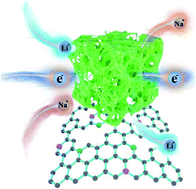Synchronously improved graphitization and surface area in a 3D porous carbon network as a high capacity anode material for lithium/sodium-ion batteries†
Abstract
Theoretically, carbonaceous materials with a high degree of graphitization and large surface area are beneficial for Li+ storage, and those with a large surface area and enlarged interlayer spacing are beneficial for Na+ storage. However, synchronously realizing them in carbonaceous materials at moderate temperatures is still a huge challenge. Herein, using bifunctional silica (SiO2), as a catalyst for graphitization of carbon and template for pore-forming, we propose a strategy to enhance the graphitization and surface area of carbonaceous materials simultaneously, besides N, P co-doping. As an anode material, the obtained 3D porous carbon network shows ideal cycling stability and excellent rate capability for both lithium-ion batteries (LIBs) and sodium-ion batteries (SIBs): outstanding reversible capacities of 1038 mA h g−1 and 238 mA h g−1 are delivered separately for LIBs and SIBs at a current of 1 A g−1. Also, it demonstrates a good rate capability at a higher current of 10 A g−1 and excellent cycling stability at 5 A g−1 for 2000 cycles for LIBs and SIBs. These results illuminate the design principle of carbonaceous materials for Li and Na storage by considering the high degree of graphitization, large specific surface area and heteroatom doping, endowing LIBs and SIBs with promising performance and applications.



 Please wait while we load your content...
Please wait while we load your content...